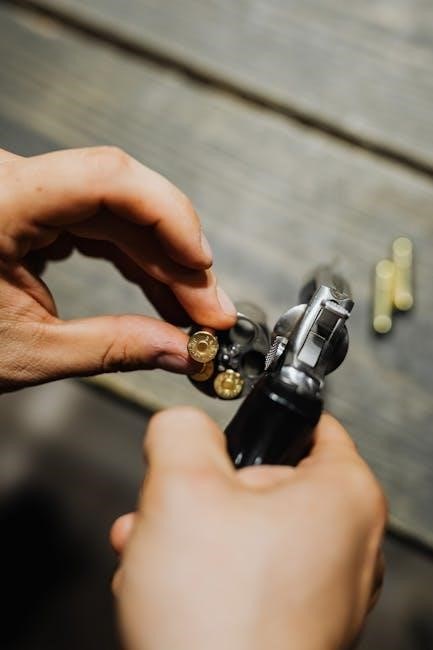
The Glock manual safety debate sparks discussion among firearms enthusiasts. Known for reliability, Glocks traditionally lack a manual safety, relying instead on trigger safety. This article explores the pros, cons, and user perspectives on adding a manual safety to Glock pistols, providing a comprehensive overview for both newcomers and experienced shooters.
1.1 Overview of Glock Firearms
Glock firearms are renowned for their durability, simplicity, and reliability. Known for their polymer frames and striker-fired design, Glocks are widely used by law enforcement and civilians. Their reputation for functioning in harsh conditions has made them a popular choice. While Glocks lack a traditional manual safety, they feature a trigger safety system. This design has sparked debate about the need for additional manual safety mechanisms, making it a key topic for discussion among firearm enthusiasts and users.
1;2 Importance of Manual Safety in Firearms
Manual safety mechanisms serve as an additional layer of control, enhancing the user’s ability to prevent accidental discharges. They provide a physical barrier, offering peace of mind during handling. For Glock pistols, which lack a traditional manual safety, the debate centers on whether such a feature would improve safety or hinder quick access. This discussion underscores the critical balance between safety and functionality in firearm design.
1.3 Purpose of the Article
This article aims to provide a comprehensive analysis of manual safety mechanisms in Glock pistols. It explores the design, functionality, and debate surrounding manual safeties, offering insights into their pros and cons. The purpose is to inform readers, addressing common misconceptions and providing practical guidance for those considering aftermarket solutions. By examining user preferences and industry expert opinions, this article seeks to enhance understanding and support informed decisions regarding Glock manual safety.

Does the Glock Have a Manual Safety?
Glock pistols do not feature a traditional manual safety switch or button. Instead, they rely on an integrated trigger safety mechanism for secure operation.
2.1 Design Features of Glock Pistols
Glock pistols are renowned for their simplicity, reliability, and polymer frame construction. They feature a striker-fired design without an external hammer or manual safety switch. The Safe Action system integrates trigger, firing pin, and drop safeties, ensuring the firearm only fires when the trigger is fully pressed. This design eliminates the need for a manual safety, prioritizing ease of use and reducing the risk of accidental discharge.
2.2 Explanation of Glock’s Trigger Safety
Glock’s trigger safety is a critical component of its Safe Action system, preventing accidental discharges. The trigger features a built-in lever that must be intentionally pressed to disengage the safety. This two-step process ensures the firearm only fires when the trigger is deliberately pulled, providing an additional layer of security without the need for a manual safety switch. This design enhances user safety while maintaining operational simplicity and reliability.
2.3 Comparison with Other Firearms
Glock’s trigger safety differs from other firearms that rely on manual safeties. Unlike pistols with external safety levers, such as the 1911, Glocks prioritize simplicity and instinctive operation. This approach aligns with modern training methodologies, emphasizing situational awareness over manual controls. While some users prefer the tactile reassurance of a manual safety, Glocks rely on their trigger mechanism to prevent accidental discharges, appealing to those who value ease of use and intuitive design in high-stress situations.

History of Glock Safety Mechanisms
Glock’s safety mechanisms were first introduced in the 1980s by Gaston Glock, focusing on reliability without manual safeties. The innovative trigger and grip safeties replaced traditional controls, ensuring accidental discharges were minimized. Over time, Glock refined these features, maintaining their reputation for functionality and simplicity, while adhering to modern safety standards and user preferences.
3.1 Evolution of Glock Safety Features
Glock safety features have evolved since their introduction in the 1980s. Initially, the focus was on trigger and grip safeties, eliminating the need for manual controls. Over time, Glock refined these mechanisms to enhance reliability and user safety. Despite debates about manual safeties, Glock maintained its signature design, emphasizing functionality and simplicity. These advancements solidified Glock’s reputation as a leader in firearms safety and innovation, catering to diverse user needs and preferences.
3.2 Historical Context of Manual Safeties in Firearms
Manual safeties in firearms date back to the early 20th century, initially designed to prevent accidental discharges. Over time, manufacturers incorporated various safety mechanisms, reflecting evolving priorities in firearm design. The debate over manual safeties continues, with some advocating for their retention and others favoring trigger-based systems. This historical context highlights the balance between safety and functionality, influencing modern designs like Glock’s approach to firearm safety mechanisms and user preferences.

Pros and Cons of Manual Safeties on Glocks
Manual safeties on Glocks offer enhanced control but may introduce delays in high-stress situations. Users debate their practicality, balancing added security with potential drawbacks in real-world scenarios.
4.1 Advantages of Manual Safety
A manual safety on a Glock provides an additional layer of security, reducing the risk of accidental discharges. It offers users a tangible control mechanism, enhancing safety, especially for new shooters. This feature can also provide psychological comfort, knowing there’s an extra step to prevent unintended firing. For some, it meets legal or training requirements, adding versatility to the firearm’s operation while maintaining its reliability.
4.2 Disadvantages of Manual Safety
The addition of a manual safety to a Glock can introduce complexity to its intuitive design, potentially leading to accidental discharges if not handled properly. It may also increase the risk of failure to disengage the safety during high-stress situations, delaying response times. Some users find it uncomfortable or awkward, and it can add unnecessary bulk and cost. Critics argue it undermines Glock’s simplicity and reliability, which are key to its popularity.
4.3 User Opinions and Preferences
Opinions on Glock manual safety are divided. Some users prefer the added layer of control it provides, particularly in high-stress situations, while others argue it complicates the firearm’s intuitive design. Law enforcement and competitive shooters often appreciate the feature, whereas traditionalists emphasize Glock’s reliability without it. Ultimately, preferences hinge on personal shooting styles, training, and perceived needs for an additional safety mechanism.

How to Use a Manual Safety on a Glock
Install an aftermarket manual safety, ensure proper handling, and always engage/disengage deliberately. Follow safety practices to maintain control and prevent accidental discharges.
5.1 Installation of Aftermarket Manual Safeties
Installing an aftermarket manual safety on a Glock requires careful consideration and mechanical aptitude. Start by selecting a reputable brand, such as Apex Tactical or Zev Technologies, known for producing high-quality aftermarket parts. Before purchasing, review installation instructions and watch tutorial videos to assess your ability to handle the process independently or if professional assistance is needed.
Ensure you have the necessary tools, such as Allen wrenches or punch tools, and verify that the firearm is completely unloaded before beginning. Follow the manufacturer’s step-by-step guide, which typically involves disassembling the Glock to access the frame. This may include removing the slide and other components to install the safety lever securely;
Pay close attention to detail to avoid damaging any parts. After installation, test the safety mechanism thoroughly to ensure it functions smoothly without interfering with the trigger or other components. If you encounter any issues or feel uncertain, consider consulting a professional gunsmith to guarantee a proper and safe installation.
5.2 Proper Handling Techniques
Proper handling of a Glock with a manual safety involves understanding its operation. Always keep the muzzle pointed in a safe direction and ensure your grip is firm. Engage the safety deliberately, avoiding accidental disengagement. Practice drawing and reholstering with the safety on to build muscle memory. Regularly inspect the safety mechanism to ensure it functions correctly. Follow manufacturer guidelines for maintenance and training to maximize safety and efficiency.
5.3 Safety Precautions
Always handle a Glock with a manual safety with caution. Keep fingers away from the trigger until ready to shoot. Ensure the safety is fully engaged when not in use. Avoid touching the safety mechanism unnecessarily, as it may disengage unintentionally. Store the firearm unloaded with the safety on. Regularly inspect the safety mechanism for proper function. Follow proper training guidelines to prevent accidental discharge, ensuring a safe shooting experience.

Glock Manual Safety Debate
The Glock manual safety debate divides enthusiasts, with some advocating for added control and others trusting its inherent trigger safety, sparking ongoing discussions about necessity and design.
6.1 Arguments in Favor of Manual Safety
Proponents argue that a manual safety adds an extra layer of control, reducing accidental discharges, especially in high-stress situations. It provides psychological comfort for some users, offering a tangible control mechanism. Additionally, shooters trained on traditional safeties may prefer the familiarity. Aftermarket options cater to this demand, allowing users to customize their Glock to meet personal safety preferences without compromising reliability.
6.2 Arguments Against Manual Safety
Opponents argue that adding a manual safety complicates Glock’s streamlined design, potentially interfering with its reliability. They emphasize that Glocks are engineered with trigger safety as a primary feature, reducing the need for an additional manual mechanism. Critics also point out that a manual safety could lead to accidental discharges if not properly engaged or disengaged. Additionally, it introduces maintenance and cost considerations, which some users find unnecessary given the Glock’s proven safety record.
6.3 Industry Expert Opinions
Firearms experts remain divided on manual safeties for Glocks. Some professionals, like competitive shooters, appreciate the added control, while law enforcement and self-defense instructors often prefer the simplicity of Glock’s original design. Many emphasize that proper training and trigger discipline are more critical than manual safeties. However, a growing number of aftermarket manufacturers are catering to the demand for manual safeties, reflecting diverse user preferences and operational needs in the firearms community.

Maintenance and Inspection of Manual Safety
Regular cleaning and lubrication of the manual safety mechanism are crucial to ensure smooth operation. Inspect for wear or debris to prevent malfunction and maintain reliability.
7.1 Cleaning the Safety Mechanism
Cleaning the manual safety mechanism is essential for optimal performance. Use a soft-bristled brush to remove dirt and debris from the safety lever and surrounding areas; Gently wipe with a clean, dry cloth to eliminate residue. For thorough maintenance, apply compressed air to dislodge particles. Avoid harsh chemicals, as they may damage the finish or internal components. Regular cleaning ensures smooth operation and prevents potential malfunctions.
7.2 Lubrication Tips
Proper lubrication of the manual safety mechanism is crucial for smooth operation. Use a high-quality gun oil, applying a small amount to moving parts. Avoid over-lubrication, as it can attract debris. Focus on the trigger bar and safety lever contact points. Improper lubrication can lead to malfunction. Regularly inspect and maintain the mechanism to ensure reliability and performance. This practice prevents wear and tear, keeping your Glock functioning safely and efficiently.
7.3 Common Maintenance Mistakes
Common mistakes include over-lubrication, which attracts debris, and using incorrect lubricants that degrade parts. Neglecting to clean the safety mechanism can cause malfunctions. Applying excessive force during maintenance can damage components. Improper reassembly or tampering with the safety without expertise risks reliability. Forgetting to maintain the safety regularly can lead to failure. Always follow manufacturer guidelines to avoid these pitfalls and ensure optimal performance and safety of your Glock manual safety mechanism.
Legal and Training Considerations
Legal implications vary by jurisdiction, with some requiring manual safety use. Training programs emphasize proper handling and safety protocols. Certification ensures compliance with local firearm regulations.
8.1 Legal Implications of Manual Safety Use
The legal implications of using a manual safety on a Glock vary significantly by jurisdiction. In some regions, the presence of a manual safety may affect the legality of carrying a firearm, particularly in states with strict firearms regulations. It is crucial for users to understand local laws regarding safety mechanisms to ensure compliance and avoid legal repercussions. Proper legal knowledge is essential for responsible ownership and use.
8.2 Training Requirements for Manual Safety
Proper training is essential for effective use of a manual safety on a Glock. Users must learn to engage and disengage the safety intuitively, ensuring it does not interfere with their ability to respond quickly. Training programs often emphasize muscle memory exercises and scenario-based drills to adapt to the added mechanism. Understanding how the manual safety integrates with Glock’s existing trigger safety is critical for safe and reliable operation. Regular practice is recommended to maintain proficiency.
8.3 Certification Programs
Certification programs for Glock manual safety provide standardized training, ensuring users master safe handling and operation. Reputable organizations offer courses covering mechanics, legal aspects, and practical exercises. These programs help shooters understand safety protocols, preventing accidents. Completing a certification enhances competence and confidence, aligning with best practices in firearms safety. Such certifications are increasingly recognized within the shooting community, promoting responsible gun ownership and usage.

Aftermarket Manual Safety Options
Aftermarket manual safeties for Glocks are available from brands like Agency Arms and Suarez, offering enhanced control. These accessories are designed for tactical and competitive use, ensuring reliability.
9.1 Popular Brands and Models
Popular brands offering aftermarket manual safeties for Glocks include Tangodown and Agency Arms. Their models, such as the Tangodown Vickers Tactical and Agency Arms DAO, are renowned for durability and functionality. These products cater to both tactical professionals and competitive shooters, providing a reliable manual safety solution without compromising Glock’s inherent reliability. They are crafted with high-quality materials, ensuring seamless integration and performance.
9.2 Installation Challenges
Installing aftermarket manual safeties on Glocks can present challenges, particularly for inexperienced users. Many require frame modification or trigger mechanism adjustments, which may void warranties or compromise reliability if not done correctly. Some kits demand precise alignment and fitting, while others may need professional installation to ensure proper function and safety. Improper installation can lead to unintended consequences, emphasizing the need for careful consideration and expertise.
9.3 Cost and Availability
Aftermarket manual safeties for Glocks vary in cost, ranging from affordable options to premium models. Prices often depend on brand, quality, and features. Popular brands like Apex or ZEV offer high-quality safeties, while budget-friendly alternatives are also available. Availability can fluctuate, with many options accessible online through retailers like Brownells or OpticsPlanet. Some models may require pre-order or extended wait times, emphasizing the importance of researching and comparing prices before purchasing.

Glock Manual Safety vs. Other Firearms
Glock’s manual safety design differs significantly from other firearms. While some handguns feature external safeties, Glock relies on internal mechanisms. This unique approach sparks debate among shooters.
10.1 Comparison with Other Handguns
Glock’s manual safety differs from other handguns, as many feature external safeties. While Glocks rely on internal mechanisms, firearms like 1911s or Berettas include manual controls. This design choice reflects Glock’s emphasis on simplicity and reliability, appealing to users who prefer consistent trigger pull without external levers. However, some shooters prefer the added control of manual safeties found in other handguns, highlighting diverse preferences in firearm design.
10.2 Unique Features of Glock Safety
Glock pistols uniquely lack a manual safety, relying on internal mechanisms such as the trigger safety and striker-fired system. This design enhances reliability and simplicity, aligning with Glock’s reputation for durability and ease of use. The absence of external controls appeals to users seeking consistent performance, setting Glocks apart from handguns with manual safeties, catering to those who prefer intuitive handling without additional levers.
10.3 Market Trends
The debate over Glock manual safety reflects broader market trends in firearms. While Glocks traditionally lack manual safeties, aftermarket options cater to those seeking additional control. Industry trends show growing interest in customizable safety features, driven by user preferences. This shift highlights the balance between Glock’s reliable design and evolving consumer demands, influencing both manufacturers and aftermarket suppliers to meet diverse needs in the firearms market.

Common Misconceptions About Glock Safety
Many believe Glocks lack safety features, but they actually have trigger and grip safeties. The misconception arises from the absence of a manual safety, which some users debate.
11.1 Myths vs. Reality
A common myth is that Glocks are unsafe due to the lack of a manual safety. In reality, Glocks feature trigger and grip safeties, reducing accidental discharges. Many believe a manual safety is essential, but Glocks’ design prioritizes simplicity and reliability. Another myth is that adding a manual safety enhances security, while it often depends on user preference and training. Understanding these differences clarifies the effectiveness of Glock’s safety mechanisms.
11.2 Media Influence on Perception
Media portrayal often shapes public perception of Glock manual safety. Movies and TV shows frequently depict Glocks without manual safeties, reinforcing their reputation as “ready to fire” weapons. This exposure can create misconceptions about their safety features. Additionally, news coverage of accidental discharges sometimes blames the lack of a manual safety, further influencing public opinion. Media narratives thus play a significant role in how Glocks are perceived in terms of safety and design.
11.3 Clarifying Misunderstandings
Common misconceptions about Glock manual safety stem from confusion between trigger safety and manual safeties. Glocks feature a trigger safety that prevents accidental discharge without a manual switch. Misunderstandings arise when users expect a traditional safety lever, unaware of the integrated trigger mechanism. Education and training are key to dispelling these myths, ensuring users understand and appreciate Glock’s unique safety design. Proper training clarifies these misunderstandings and promotes safe handling practices.
The Glock manual safety debate highlights key considerations. Glock’s design emphasizes simplicity and reliability without a manual safety. Understanding its safety features is crucial for responsible ownership. This conclusion underscores the importance of education and safe handling practices for all users.
12.1 Summary of Key Points
The Glock manual safety discussion revolves around its unique design, emphasizing trigger safety over traditional manual safeties. Key points include Glock’s reliance on passive safety mechanisms, the debate over adding manual safeties, and considerations for users regarding handling, training, and legal implications. Understanding these elements is essential for informed decision-making and responsible firearm ownership. This summary encapsulates the core aspects of the Glock manual safety conversation, providing a clear overview of the topic.
12.2 Final Thoughts on Glock Manual Safety
The Glock’s lack of a manual safety sparks ongoing debate, with proponents emphasizing its streamlined design and inherent trigger safety. Critics argue for the added security of a manual mechanism. Ultimately, Glock’s design philosophy prioritizes simplicity and reliability, trusting users to adhere to safe handling practices. The decision to use a manual safety remains a personal choice, reflecting individual preferences and operational needs.
12.3 Recommendations for Users
Users considering a Glock manual safety should prioritize proper training and handling techniques. Always follow safety protocols, such as keeping the finger off the trigger until ready to shoot. For those opting for aftermarket safeties, ensure professional installation and regular maintenance. Ultimately, whether using a manual safety or relying on Glock’s built-in features, consistent practice and adherence to safety guidelines are paramount for responsible firearm ownership.